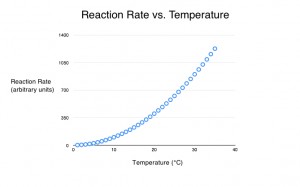This is another installment in the Enzymes for Brewers series.
The rate of an enzymatic reaction increases with temperature. This is because the molecules in solution are traveling at a higher speed, lowering the average time it takes for them to collide. Back in 1889, the Dutch chemist Svante Arrhenius derived a simple equation that showed the effect of temperature on the rate of any chemical reaction. Basically, his equation predicts that the rate of any chemical reaction will increase exponentially with temperature. Experiments have shown that his equation is remarkably accurate for a wide range of chemical reactions.
In chemistry, a rough rule of thumb is that, for every 10 °C increase in temperature, the rate of a reaction doubles. This is only an approximation, and the exact rate of increase depends on a rate constant specific to each reaction. (A rate constant is just a number that describes how fast the reaction proceeds. It has to be measured for each specific reaction.) However, for a surprisingly wide number of “simple” chemical reactions, this rule of thumb is “close enough” for most practical purposes. If the reaction is actually a net reaction of a series of chemical reactions, or a cascading reaction, this approximation can be way off.


Recent Comments